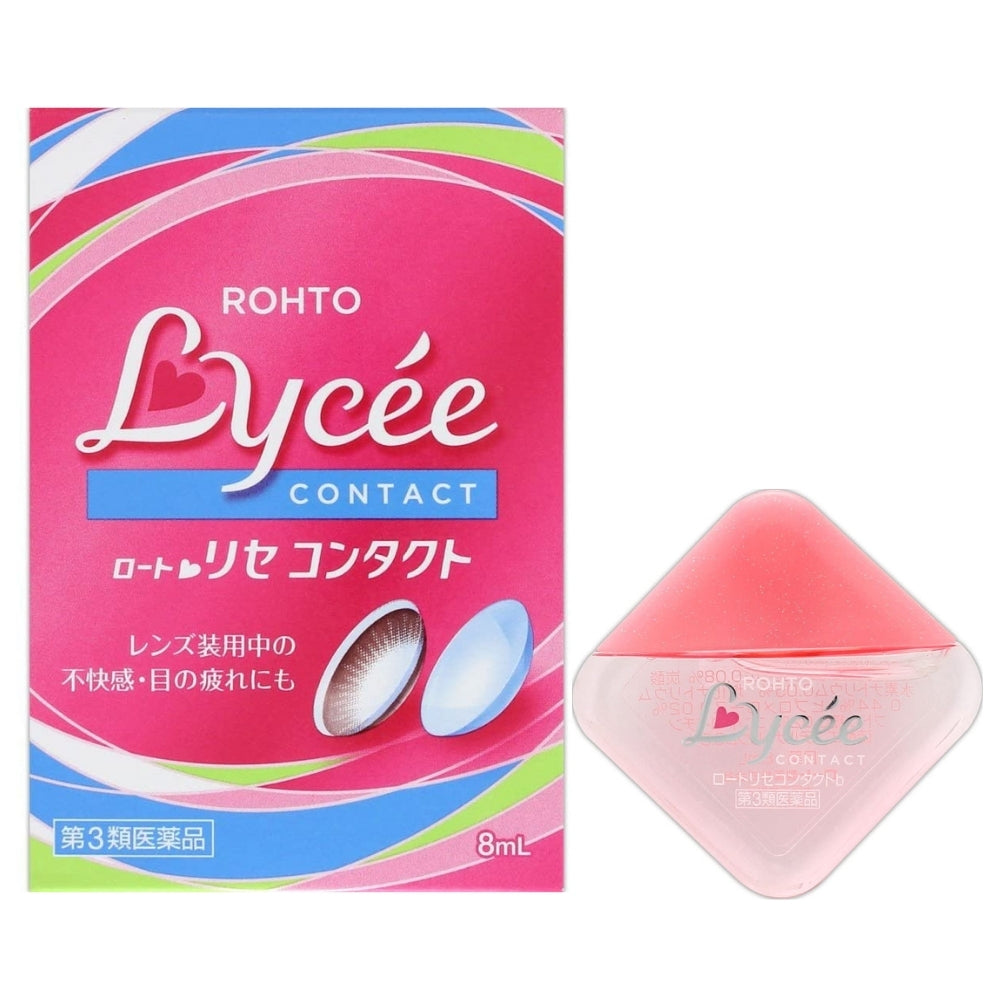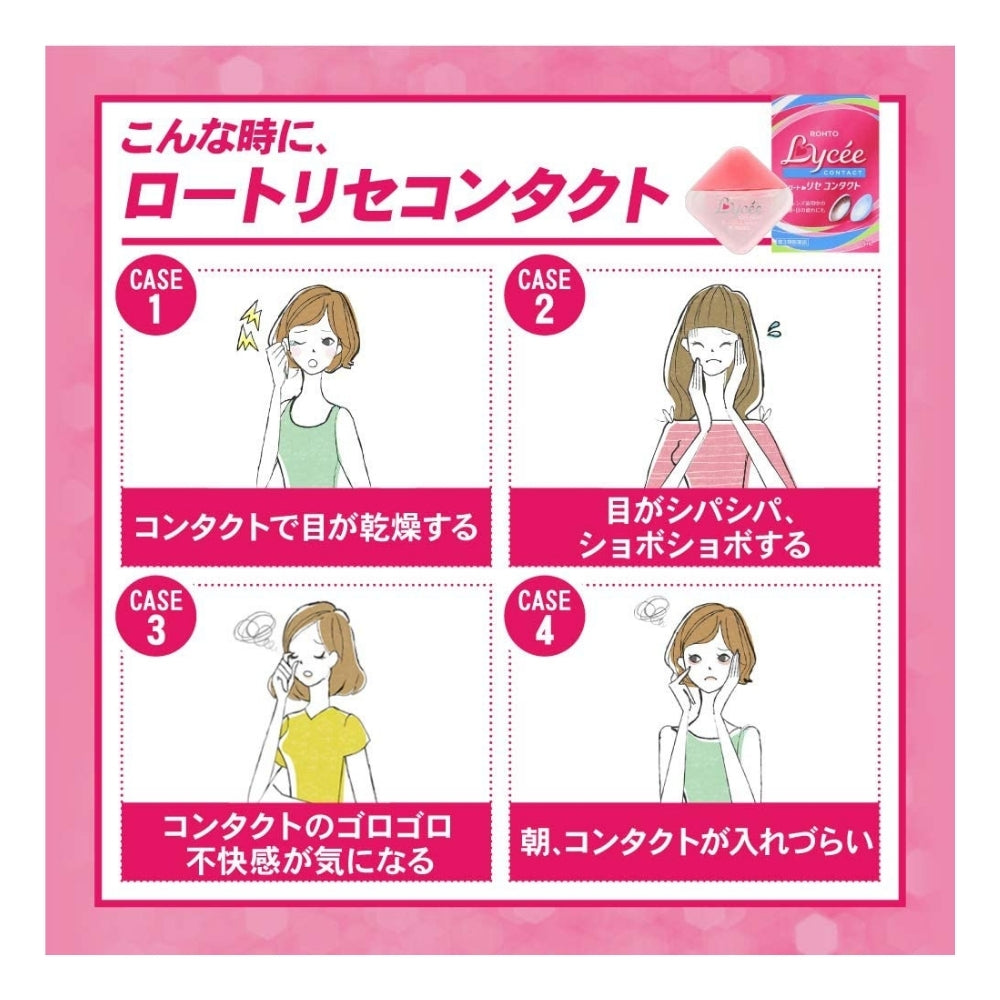Description
The composition includes 5 components for moisturizing:
- Sodium chondroitin sulfate (0.5%) - to protect the cornea, moisturizes, preventing dry surface of the eye
- Potassium chloride 0.08% - to regulate pressure in cells, amino acid transfer, nervous impulses
- Sodium chloride 0.44% - to eliminate edema
- Sodium bicarbonate 0.05% - for antiseptic action
- Hydoxyethyl cellulose - HEC 0.02% - for the formation of a protective film, ensuring the astringent effect.
Rohto Lycee Contact is soft drops recommended when wearing contact lenses of any type.
ROHTO LYCEE CONTACT drops are the best way to moisturize the surface of the eyes when wearing lenses of any type - hard, colored, soft, etc. The drug has a low level of freshness, that is, the sensations of use will be as close as possible to washing the eyes with a natural tear.
The preparation includes useful ingredients - hydroxyethyl cellulose (gypromellose), as well as chondroitin. The tool will become an excellent method of preserving the surface of the organs of vision moisturized, which prevents the pathology of the mucous membrane. In addition, moisturizing the eye increases the viscosity of the liquid part of the epithelium, softens the cornea and provides it with protection from the effects of external factors, such as friction about the lens.
The composition of drops includes minerals that can regulate the pressure inside the eye and reduce edematous phenomena. Caliophy chloride is the transport of amino acids, ensures the normal conduct of nerve impulses.
Sodium bicarbonate is a good antiseptic necessary to relieve inflammation and prevent eye infection. A similar composition of the product eliminates the negative effect of lenses on the surface of the eye.
Freshness index of drops - 3
Rohto Lycee Contact is a very delicate and mild solution even for owners of sensitive eyes. In the new design, Rohto Lycee Contact ophthalmological drops have been produced since 2014.
Peculiarities :
- prolonged moisture of the organs of vision due to the presence of chondroitin, hydroxyethyl cellulose in the composition
- antiseptic effect;
- anti -reducing properties;
- Reducing pressure inside the eyes, optimization of the transport of nutrients, which is ensured by the presence of minerals.
It is recommended to use:
- fatigue, reins, tension of the organs of vision
- dry surface of the eyes
- visual impairment against the background of mucus accumulation
- getting into the eyes of pollution, infectious particles
Other drops of drops: drilling, castor oil polyoxyethylene, boric acid, polypropylene glycol (Plaxamers), sorbic acid, ethylendiamineter of sodium, geraniol, L-Mentol, pH agent.
Recommendations for use:
With light fatigue - one drop in each eye.
With severe fatigue-2-5 times a day 1-2 drops.
The capacity of the bottle: 8 ml.
Contraindications:
- eye treatment with other drugs
- Allergic reaction to drops components
- Allergic reactions caused by the use of other drugs
- Chronic severe pain in the eyes
- With the diagnosis of glaucoma
Symptoms, when which you should stop taking drops:
- The appearance of a rash and redness on the skin
- irritation and edema of the eyes, severe itching
Precautions and storage requirements:
- Store in dark and cool, inaccessible to the sun, a place with a closed lid
- protect from high temperatures and mechanical deformations
- Do not pour into another container
- Protect from children
- Do not touch the droppers with eyelashes and fingers, to prevent the composition of the composition
- instill only in the eyes
- Do not use together with other people
- Do not use after the expiration date
- over time, white crystals can form in the container, drops can be used by strain through gauze
A detailed description of each of the drops of drops ROHTO LYCEE CONTACT
Sodium chondroitin sulfate And sodium hyaluronate - biological polymers concentrated in an extractular matrix of both animals and humans. The cornea is the fabric of the eye that has the greatest concentration of sodium chondroitin sulfate, while watery moisture of the eye and ST contain the greatest concentration of sodium hyaluronate.
Aminocapronic acid (epsyylon) - a substance that reduces the inflammation and production of plasminogen. It also has a hemostatic effect, contributing to the processes of cameling during bleeding associated with fibrinolysis (with an increase in blood fibrinolytic activity). The specific hemostatic effect of aminocapronic acid is to stop plasminogen activators and block the action of plasmine. Aminocapronic acid is also used to stop bleeding during surgical interventions and various pathological conditions, accompanied by an increase in the fibrinolytic activity of blood and tissues (liver diseases, acute pancreatitis, etc.), with hypofibrinogenemia; With burn disease and shock, with bleeding associated with leukemia and hypoplastic anemia, with hemophilia. Aminocapronic acid is removed from the body with the kidneys quite quickly.
.


